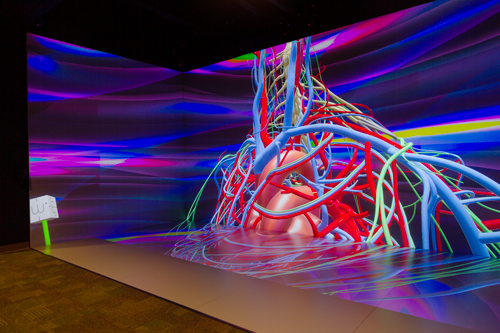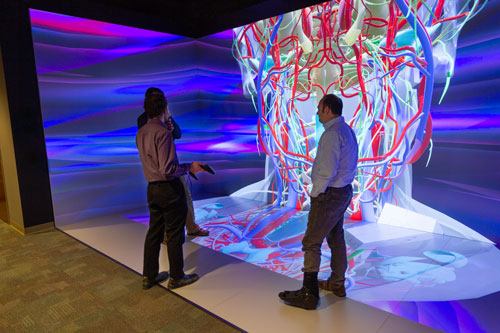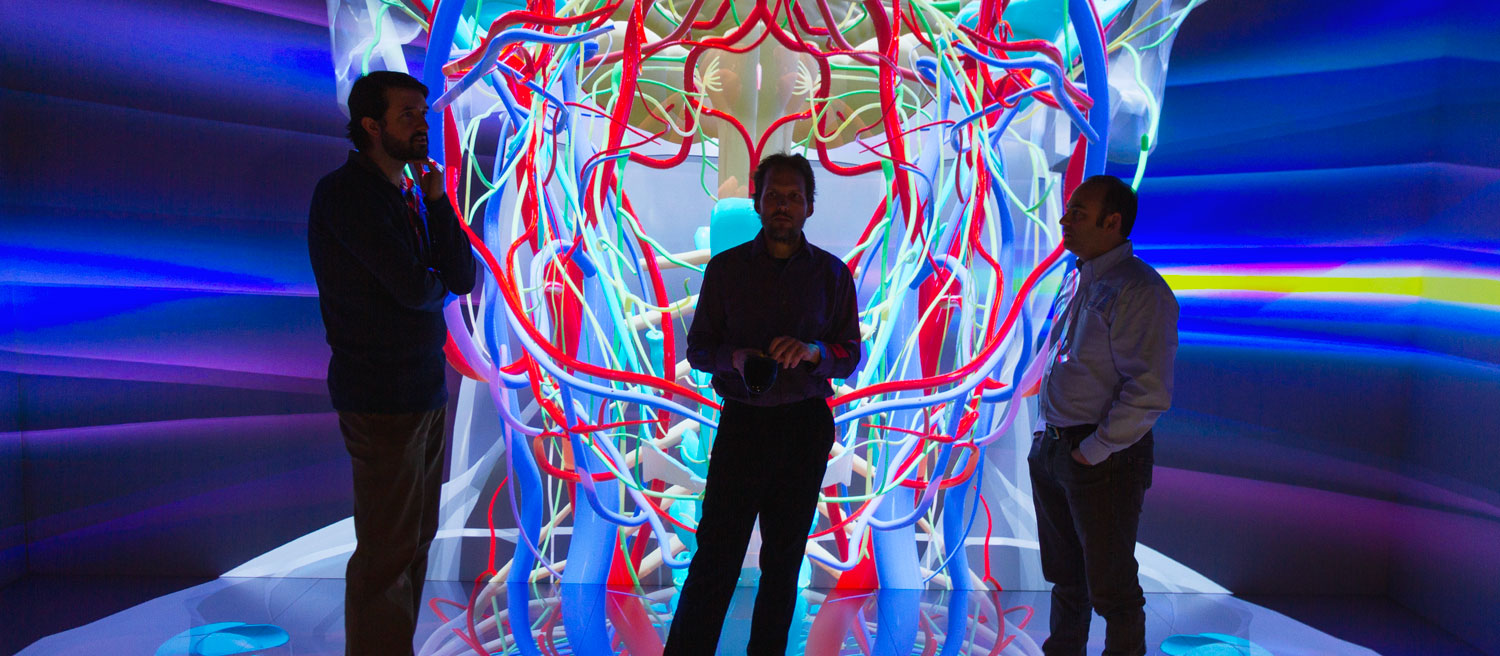Marquette’s VisLab Cave Reopens Under New Leadership
The reopening of Marquette’s VisLab Cave offers enhanced educational opportunities for students
 The Marquette Visualization Laboratory is a unique space that heightens the educational and research outcomes for a vast array of projects. Engineers and Biomedical Researchers can more easily make detailed distance measurements between artery endpoints or brain structures. Architecture students may experience historic buildings that have been lost to time. Arts enthusiasts may integrate performance-based art forms with immersive, moving-image media, and biology and medical students may study complex anatomical systems at a scale and level of clarity that would otherwise prove unattainable.
The Marquette Visualization Laboratory is a unique space that heightens the educational and research outcomes for a vast array of projects. Engineers and Biomedical Researchers can more easily make detailed distance measurements between artery endpoints or brain structures. Architecture students may experience historic buildings that have been lost to time. Arts enthusiasts may integrate performance-based art forms with immersive, moving-image media, and biology and medical students may study complex anatomical systems at a scale and level of clarity that would otherwise prove unattainable.
Located in the bottom floor of Engineering Hall, Marquette’s Visualization Laboratory—or VisLab, for short—contains an immersive, multi-media learning environment where audience members are invited into an encompassing space created by projections cast onto three walls and the floor. The VisLab enhances these immersive experiences with an interactive component that allows presenters to navigate through this 3-dimensional environment with use of state-of-the-art gaming technology. These added layers of functionality further enhance engagement and allow for complex simulation experiences that are more impactful than the traditional lecture or PowerPoint formats.
As a result of COVID restrictions placed on in-person gatherings, the in-person component of Marquette’s VisLab has been on hiatus for the past two years, but with the gradual lifting of restrictions on campus activity and a team of new directors, the VisLab’s Cave is priming for a reboot.
Drs. Robert Cooper and Adam Greenberg of the Marquette University and Medical College of Wisconsin Joint Department of Biomedical Engineering specialize in the research and development of sensory systems. More specifically, Dr. Robert Cooper develops and uses functional imaging tools for the retina—the tissue at the back of the eye that senses light. Dr. Adam Greenberg, who was also recently appointed Assistant Dean of Postdoctoral Education in the Medical College of Wisconsin School of Graduate Studies, conducts research surrounding sensory neuroscience and perception, investigating how the brain processes the complex stimuli captured by our eyes, ears, and nose. Under their direction, the Marquette Visualization Laboratory seeks to explore the capabilities of this immersive technology by inviting projects from across disciplines and facilitating project proposals from not only faculty across all colleges, but artists and graduate students, as well.
The technical side of Marquette Visualization Laboratory is run by Christopher Larkee, Visualization Technology Specialist at Marquette University. Sporting a BFA from University of Wisconsin—Madison, as well as several years' experience working in broadcast engineering in the Milwaukee area, Larkee manages computers, trackers, and projectors lining the virtual space, as well as the gaming and rendering technology used to transform proposed projects into interactive, 3-dimensional masterpieces enjoyed by all.
 When projects are submitted, Larkee produces a 3-D computer model that supports the necessary content. He then runs the computer model through the real-time development platform Unity, making the models interactive. Projects using previously modeled 3D objects and environments can be ready for display in as little as two weeks. In addition, Larkee supports the creation of online learning modules that supplement material covered in VisLab’s interactive space, a role that he has polished over the two-year break of the lab’s in-person experience.
When projects are submitted, Larkee produces a 3-D computer model that supports the necessary content. He then runs the computer model through the real-time development platform Unity, making the models interactive. Projects using previously modeled 3D objects and environments can be ready for display in as little as two weeks. In addition, Larkee supports the creation of online learning modules that supplement material covered in VisLab’s interactive space, a role that he has polished over the two-year break of the lab’s in-person experience.
Immersive learning experiences offer students the opportunity to engage with larger-than-life virtual replications of relevant material in any discipline. These experiences enhance learning by providing engagement, facilitating a communal environment, and adding that little bit of ‘pop’ that aids in retention of important information. If this weren’t enough, these experiences offer multisensory stimulation, facilitating unique opportunities for aesthetic engineering—creating a space with a certain feel.
For more information on how your project can be bolstered by this unique and engaging space, contact Dr. Robert Cooper, Dr. Adam Greenberg, or VisLab Technology Specialist Christopher Larkee.
Learn more about VisLab


 The Marquette Visualization Laboratory is a unique space that heightens the educational and research outcomes for a vast array of projects. Engineers and Biomedical Researchers can more easily make detailed distance measurements between artery endpoints or brain structures. Architecture students may experience historic buildings that have been lost to time. Arts enthusiasts may integrate performance-based art forms with immersive, moving-image media, and biology and medical students may study complex anatomical systems at a scale and level of clarity that would otherwise prove unattainable.
The Marquette Visualization Laboratory is a unique space that heightens the educational and research outcomes for a vast array of projects. Engineers and Biomedical Researchers can more easily make detailed distance measurements between artery endpoints or brain structures. Architecture students may experience historic buildings that have been lost to time. Arts enthusiasts may integrate performance-based art forms with immersive, moving-image media, and biology and medical students may study complex anatomical systems at a scale and level of clarity that would otherwise prove unattainable. When projects are submitted, Larkee produces a 3-D computer model that supports the necessary content. He then runs the computer model through the real-time development platform Unity, making the models interactive. Projects using previously modeled 3D objects and environments can be ready for display in as little as two weeks. In addition, Larkee supports the creation of online learning modules that supplement material covered in VisLab’s interactive space, a role that he has polished over the two-year break of the lab’s in-person experience.
When projects are submitted, Larkee produces a 3-D computer model that supports the necessary content. He then runs the computer model through the real-time development platform Unity, making the models interactive. Projects using previously modeled 3D objects and environments can be ready for display in as little as two weeks. In addition, Larkee supports the creation of online learning modules that supplement material covered in VisLab’s interactive space, a role that he has polished over the two-year break of the lab’s in-person experience.